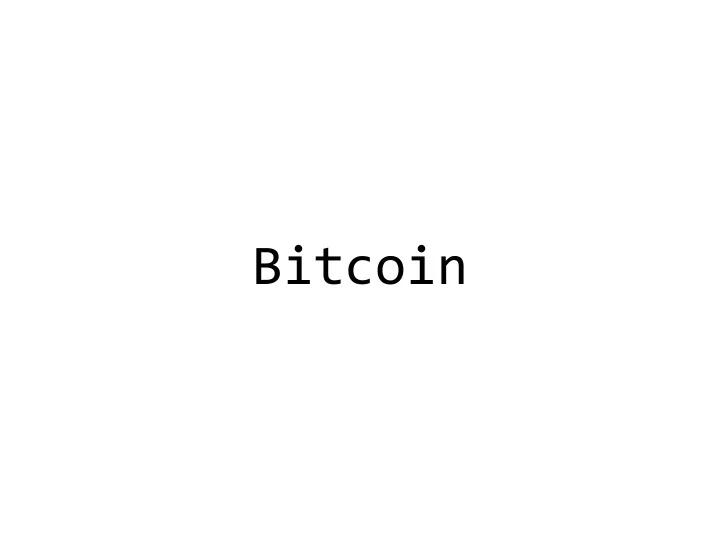

Bitcoin
What We Know So Far • Consensus • Cryptographic Primitives
Today • Putting It All Together • The Bitcoin System
The First Primitive
Data Structure
Reference Reference Header Header Header Transactions Transactions Transactions
How Do You Communicate? • Broadcast • Relay
Growing This Thing • Add blocks • Which include transactions
Growing This • Incentive to add blocks • Miners • Full Node • Block subsidy
The Subsidy • 12.5 BTC • Halves again mid-2020-ish
The Coinbase Transaction Header Header Coinbase Transactions ——————————— Transactions
Malicious? • Give yourself BTC • All manner of invalid transactions
How Do You Deter This?
Impose a Cost • What kind of cost? • Computational
Ingredients • A Preimage-Attack Resistant Hash Function • SHA-256 • An Evolving Challenge • Evolve in response to network realities
The Challenge • H(x) < TARGET
X? • Checksum of block header • Current protocol version • A reference to a prev block • A timestamp • .... • NONCE
Nonce? • A one-time use value
Mining • Miner can set this nonce • (note the rest are pretty much pre- determined)
The Challenge • Pick that nonce • So that the block hash < TARGET
SHA-256 • Output looks random • Preimage attack resistant • One-way
TARGET • 00000FFFFF…. • Hex string • Probability of leading zeros?
TARGET • SHA-256?
Proof Of Work
Some Algebra • P = (TARGET+1) / 2^256 • Likelihood of getting your value right • Expected value: • 2^256 / (TARGET+1)
Protocol • Approx 10 minutes per block • So Given The Total Hash Rate (TH/s) • Compute Expected Time for block to be mined by the network
Estimating THR • Look at previous 2016 blocks • Update every 2016 blocks • DIFFICULTY
Target • DIFFICULTY = (Difficulty target) / (current target)
An Evolving Challenge • Total Hashing Power • GPUs • ASICs • 80e6 TH/s
Protocol Limits • 10 minutes per block • So total # of potential hashes: • 60 x 10 x 80e6 hashes in this period • Pick a target so that expected # of trials aligns with this hash rate
Commit?
Commit • Other miners build on top of this block
Race Conditions
2 Miners • Both mine valid blocks • Both broadcast their blocks to the network • People accept both and start building on them
Fork • It is unlikely: • Both branches will grow indefinitely equally • Someone in 1 branch will see a block from the other branch • PROTOCOL: Longest branch must be honored
Fork • Stale blocks • All coinbase transactions are discarded • Other transactions are part of the next pool to build blocks from
Fees • Block Reward: • Block subsidy • Transaction Fees
Higher Fee • Miners likelier to include your transaction • How do you estimate what fee is good? • Records time of listen -> time to include • Reliable estimates
Tale Of A Bitcoin Coinbase Spend Spend Transaction Coin Coin (Alice) (Bob) (Jair)
Transaction Data Structure • Input (zero or more) • Output (one or more)
A Coinbase Transaction • No inputs
A Regular Transaction • (Signature (with pubkey), Amount)
Alice Gives X BTC To Bob • (Sign_Pubkey(bob_pubkey), X) • (One of) the output
Referencing A Txn • Double SHA-256(txn)
Bob Spends X • Point to where X is: • Txn id • Point to the output that contains the BTC • Satisfy the conditions • (priv key)
Transaction State • Spent • Unspent
You Can Only Spend • The unspent • UTXO
Block Header • Merkle Tree Root: Checksum of Transactions
Double Spend • Alice, Bob • Alice pays Bob bitcoin • Alice creates 2 blocks: • Bitcoin x paid to Bob: t1 • Bitcoin x paid to Alice: t2
What Happens • Only 1 of these can be in the blockchain • Alice broadcasts t1 • Hides t2 • t1 is included in a block
And Then • Alice begins working on t2 • Broadcasts t2 out
2 Cases • Alice controls >= 50% of the hash rate • Alice controls < 50% of the hash rate
Case I • If Alice controls > 50% of the hash rate • Alice can exclusively mine blocks assuming the block (Containing t2) is the right one • And Alice will win
Case II • Depends on how much compute power Alice has • The longer you wait (i.e. more blocks built on top of the block containing t1) • the lower the likelihood of getting hoodwinked
Waiting • Confirmations: • # of blocks passed since “the one”
Altering The Chain • How?
Recommend
More recommend